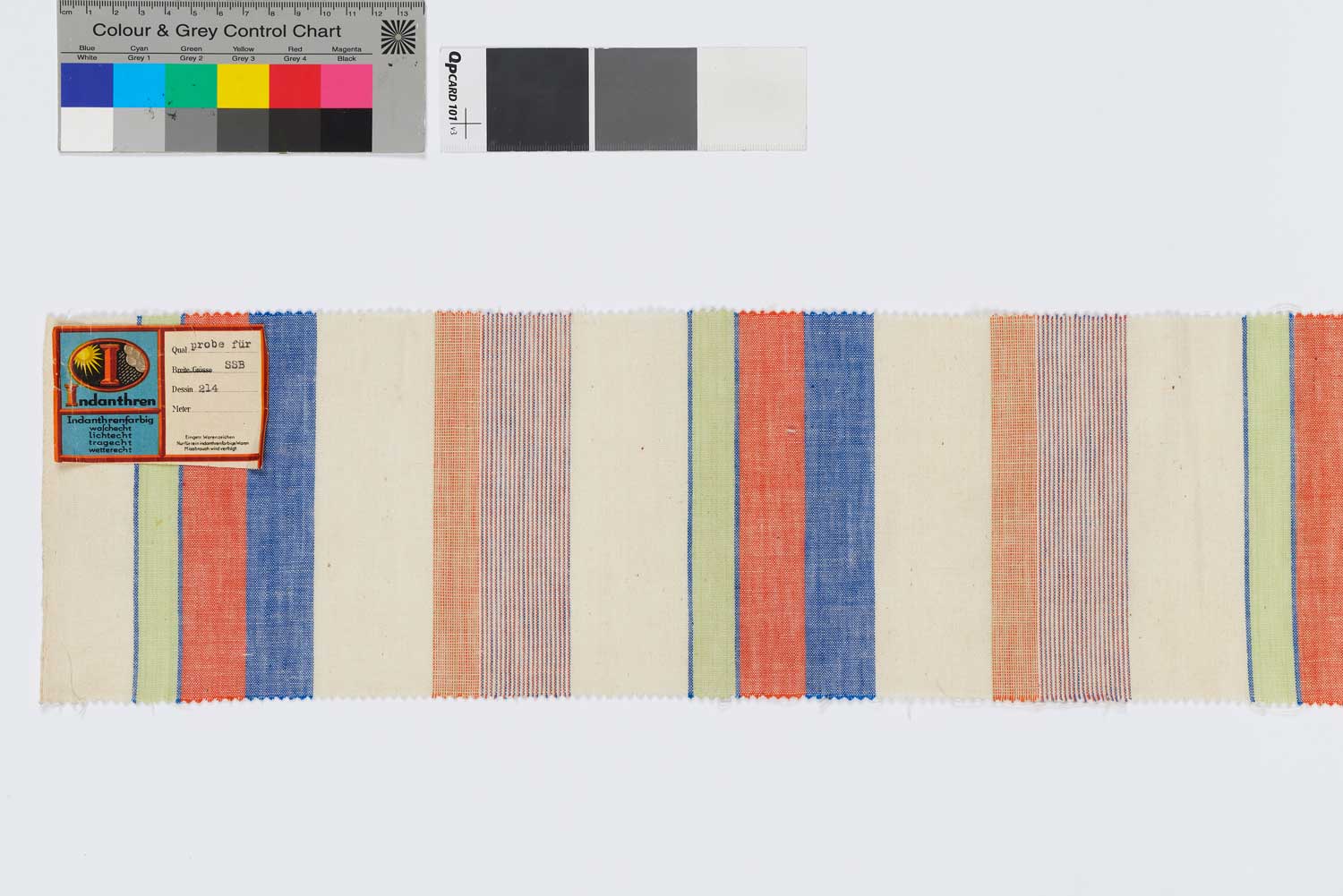The Deutsche Werkstätten Hellerau (Hellerau German Workshops) designers | Times of change
After the First World War, the spirit of optimism evident in the first few years began to falter slightly because women were increasingly pushed into marginal artistic areas such as textile art. The Deutsche Werkstätten (German Workshops) responded to the high demand for modern utility textiles by founding a subsidiary, Deutsche Werkstätten Textilgesellschaft (German Workshops Textile Company) . Once again, numerous women enriched the Deutsche Werkstätten (German Workshops) product range with their designs for fabrics and wallpapers, even though their work has remained almost unappreciated until now.
Content of this article

Sample coupon with label "Indanthren", Bertha Senestréy (design), DEWETEX (execution), around 1925.
Kunstgewerbemuseum, Staatliche Kunstsammlungen Dredsen, Inv.-Nr. 53322. © Staatlichen Kunstsammlungen Dresden. Kunstgewerbemuseum / Robert Vanis.
The second generation (1918 to 1938)
The spirit of optimism evident in the first few years, which produced such a diverse collaboration of women involved in the reform movement at the Deutsche Werkstätten (German Workshops), stagnated after the First World War. Although there were still quite a few women working as artistic collaborators after the war, they were mainly to be found in the field known as textile structural art. Although schools of arts and crafts and other educational institutions increasingly opened up to women and the professionalisation of women’s work was expanded, contemporary discourse on women’s specific artistic abilities pushed them into marginal areas such as textile art. As female creativity could no longer be prevented, they at least tried to keep it under control. Despite the opening of most academies in 1919, this trend finally culminated in the exclusion of women at the Bauhaus a year later.
Nevertheless, women continued to design for the Deutsche Werkstätten (German Workshops) or sell products through the company, thereby influencing its product range and making a significant contribution to its image. Due to the marginalisation of their contributions and the disappearance of their works from the focus of historiography, some important aspects of the company’s history have also been temporarily forgotten.
Textile and wallpaper
With the founding of the subsidiary Deutsche Werkstätten Textilgesellschaft (German Workshops Textile Company) in 1923, the Deutsche Werkstätten (German Workshops) wanted to respond to the high demand for modern utility textiles such as carpets, curtains, upholstery fabrics or tablecloths. To meet the rapid change in tastes in this segment and to offer customers the widest possible range of modern designs, the Deutsche Werkstätten (German Workshops) had built up an extensive network of designers. In addition to Josef Hillerbrand, Karl Bertsch, Heinrich Sattler, and Ernst Böhm, mainly Lisl Bertsch-Kampferseck, Elisabeth Eimer-Raab, Ruth Hildegard Geyer-Raack, Irmgard Harras, and Bertha Senestréy provided designs for the textile company. A similar density of female designers can be observed in the field of the Deutsche Werkstätten Hellerau’s (Hellerau German Workshops) wallpaper designs. Emmy Seyfried, Lotte Frömmel-Fochler, and Wanda Gmelin particularly stand out here. Most of these female designers provided the Deutsche Werkstätten (German Workshops) with designs for textiles as well as wallpapers.
Else Wenz-Viëtor was one of the later successful female designers for the Deutsche Werkstätten (German Workshops). Over a period of two decades, she constantly developed her style and had a significant influence on the Deutsche Werkstätten’s (German Workshops) range. Given the abundance and aesthetic quality of her designs, it is surprising that this area of her work has remained almost unappreciated until now. She designed glass, metal, and porcelain vessels as well as lamps and carpets for the company in addition to furniture as early as the beginning of the 1910s.
